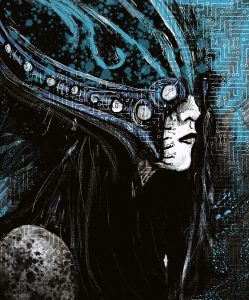An essay by Professor Josef Austin, as provided by Candida Spillard
Art by Luke Spooner
(Paper to have been submitted by Professor Josef Austin of Harvard, currently on secondment to the U.K. Ministry of Defence, to “IEEE Transactions, Medical Devices,” but withdrawn having been found to contain Classified material. This copy provided by Candida Spillard, a former volunteer subject of Professor Austin’s, who came across it while sorting paper for recycling and is releasing the findings for the Public Good.)
Abstract
This paper presents the Inverse Polygraph, a new device for use in Psychotherapy or other fields in which new patterns need to be introduced into the minds of unwitting subjects.
Appearing as a polygraph or “lie detector,” the device includes an extra pair of sets of electrodes that fit on the subject’s temples and deliver stimulant electrical pulses to specific locations in the brain.
We report success in implanting a specific idea into the brains of a large number of British subjects.
Introduction
Polygraphs, more colloquially known as “lie detectors,” are regularly used in security vetting and police questioning. For this reason, subjects do not generally find their application threatening or intimidating; indeed, a good investigator should be able to put a subject at their ease so as to avoid the possibility of “false positive” readings.
The Inverse Polygraph is a conventional “passive” (i.e., receive-only) polygraph with an extra, active functionality. This takes the form of a pair of hand-sized modules that fit over the subject’s temples and, using conventional phased-array antenna technology, deliver electromagnetic stimuli to specific locations in the brain.
In this way, “memories” and associations can be implanted into subjects without their knowledge, while they believe themselves to be undergoing straightforward questioning.

Our initial tests consisted of asking a large number of volunteer subjects to recall a specific event, namely voting for the party of their choice at a general election, while E.E.G. traces were recorded. Subjects were told that the aim of the research was to find out the extent to which weather conditions influenced voting behaviour.
To read the rest of this story, check out the Mad Scientist Journal: Winter 2017 collection.
Professor Josef Austin was born in Austria and came to the United States at the age of six with his parents. At the age of eight, he successfully trained a spider to obey simple prompts such as “Forward March!” before removing its legs and concluding after observing its subsequent behaviour that spiders hear with their feet.
A stellar career in experimental psychology was the natural next step. However, little is known about his work, owing to most of its being carried out in conditions of strict secrecy.
Candida Spillard is a lapsed physicist, having researched for over twenty years into the effect the weather has on radio wave reception. She was also a broadcasting technician back in the days when video machines were too heavy to lift. She has a passion for all things environmental, self-sufficient, or just plain eccentric. She has sometimes been used for scientific experiments, but has never knowingly come to harm. Except the occasional migraine …
Luke Spooner a.k.a. ‘Carrion House’ currently lives and works in the South of England. Having recently graduated from the University of Portsmouth with a first class degree he is now a full time illustrator for just about any project that piques his interest. Despite regular forays into children’s books and fairy tales his true love lies in anything macabre, melancholy or dark in nature and essence. He believes that the job of putting someone else’s words into a visual form, to accompany and support their text, is a massive responsibility as well as being something he truly treasures. You can visit his web site at www.carrionhouse.com.
“The Inverse Polygraph: A New Device for Implanting Thought Patterns” is © 2017 Candida Spillard
Art accompanying story is © 2017 Luke Spooner

Read your story. It was so convincing that I was in danger of believing the whole concept. Brilliant! Makes me wonder whether it’s safe to wear a hat.